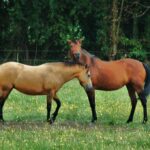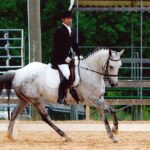Teaching a horse to move away from leg pressure is fundamental to developing clear communication between rider and mount. This essential skill, known as yielding to leg pressure, forms the foundation for nearly all advanced riding techniques. When a horse properly responds to leg cues, riding becomes more intuitive, movements flow naturally, and the partnership between horse and rider strengthens. Whether you’re working with a young horse or refining the training of an experienced mount, understanding how to effectively teach this skill will dramatically improve your riding experience and create a more responsive, willing equine partner.
Understanding Why Leg Pressure Is Important

Leg pressure serves as one of the primary communication tools between rider and horse, creating a sophisticated language that allows for precise control and guidance. When correctly applied, leg pressure enables riders to control the horse’s direction, speed, and body position without relying on harsh bits or excessive rein contact. This skill forms the foundation for lateral movements, collection, extension, and virtually all advanced maneuvers in disciplines ranging from dressage to western riding. Furthermore, a horse that responds appropriately to leg cues is generally safer to ride, as the rider can quickly position the animal away from dangerous situations or obstacles. Mastering this communication system ultimately leads to more harmonious riding with minimal effort from both parties.
The Science Behind Pressure and Release

The effectiveness of teaching leg pressure response relies on the fundamental principle of pressure and release training, sometimes called negative reinforcement in learning theory. In this approach, pressure (the leg cue) is applied until the horse offers the desired response, at which point the pressure is immediately removed as a reward. This release of pressure serves as reinforcement, teaching the horse that a specific movement results in comfort. The timing of the release is crucial – it must happen precisely when the horse makes the correct movement, even if that movement is initially small. Over time, the horse learns to associate specific leg pressures with particular movements, responding more quickly to lighter cues. This method works with the horse’s natural instincts rather than against them, making learning more efficient and less stressful for the animal.
Essential Equipment for Training

When teaching a horse to move off leg pressure, having the right equipment contributes significantly to training success and safety. Start with a well-fitted saddle that allows you to maintain a balanced position and apply leg aids clearly without sliding around. A saddle with secure leg position will help you deliver consistent cues. For beginning this training, use a gentle bit or even a sidepull or rope halter that won’t cause mouth discomfort that might distract from the leg lessons. Many trainers prefer working in an enclosed area like a round pen or small arena with good footing to provide security and focus for both horse and handler. Consider using protective boots on your horse’s legs if you’ll be practicing tight turns or lateral work. Remember that minimal equipment is often best – the goal is clear communication, not mechanical control.
Starting with Groundwork Fundamentals

Before mounting, establishing respect and understanding through groundwork creates a solid foundation for under-saddle training. Begin with basic yielding exercises using a training stick or your hand to apply gentle pressure to the horse’s side, mimicking the location where your leg would rest while riding. Apply steady pressure until the horse takes even a small step away, then immediately release the pressure and offer praise. Practice this on both sides of the horse until responses become consistent and require less pressure. Gradually refine these movements, asking the horse to move the hindquarters and forequarters independently in response to pressure in different areas. This groundwork teaches the horse the basic concept of moving away from pressure before you introduce the complexity of rider weight and leg cues from the saddle. Additionally, these exercises help establish your leadership role and the horse’s trust in your communication system.
Mounting and Initial Ridden Exercises

When transitioning to mounted work, begin in a controlled environment where both you and your horse can focus without distractions. After mounting, sit quietly and allow your horse to adjust to your weight before asking for any movement. Start with basic forward motion, applying gentle, even pressure with both legs while maintaining a relaxed, balanced seat. The moment your horse steps forward, release the pressure and offer verbal praise. If the horse doesn’t respond, increase the pressure gradually rather than suddenly kicking, which might startle or confuse your mount. Once your horse consistently moves forward from light leg pressure, practice stopping and starting several times, reinforcing the connection between your leg cue and the desired forward movement. Keep these initial sessions short and positive, ending on a successful note to build your horse’s confidence and understanding.
Teaching Directional Responses

Once your horse understands basic forward movement from leg pressure, you can begin teaching directional responses that form the basis of steering and lateral work. Start by applying pressure with your outside leg slightly behind the girth to ask the horse to bend around your inside leg. Your inside leg maintains light contact at the girth to create a supportive “corridor” for the horse to move through. When the horse makes even a small step in the correct direction, immediately release the pressure and praise. Practice this in both directions at the walk, using large circles initially before attempting tighter turns or more complex patterns. Remember to coordinate your leg aids with appropriate rein and weight cues for clarity – your outside rein prevents over-bending while your weight shifts slightly in the direction of movement. Be patient during this phase, as horses often find it more challenging to understand sideways pressure than the forward cues they learned first.
Developing Lateral Movement Skills

Lateral movements represent an advanced application of leg pressure response, teaching the horse to move sideways while maintaining forward momentum. Begin with the leg-yield, a basic lateral movement where the horse moves forward and sideways simultaneously. Position your horse on a straight line, then apply pressure with your inside leg at the girth while supporting with your outside leg behind the girth. Your inside rein maintains a slight bend in the direction opposite to the movement, while your outside rein guides the shoulder. When the horse takes even a single correct step, crossing the inside hind leg in front of the outside hind, release pressure and praise. Practice this movement from centerline to wall and eventually from wall to centerline as your horse’s understanding improves. Gradually progress to more complex lateral movements like shoulder-in and haunches-in as your horse’s responsiveness to leg pressure becomes more refined, remembering that each new movement builds upon the fundamental principle of moving away from pressure.
Troubleshooting Common Resistance Issues

When teaching horses to respond to leg pressure, several common resistance patterns may emerge that require specific solutions. If your horse ignores leg cues entirely, check whether your signals are clear and consistent – inconsistent pressure teaches horses to tune out leg aids. For horses that speed up instead of moving laterally when leg pressure is applied, practice frequent transitions between gaits to establish better speed control before returning to lateral work. When confronting a horse that becomes tense or anxious with leg contact, begin with very light pressure and build tolerance gradually, possibly returning to groundwork temporarily. Horses that kick at your leg or pin their ears may be experiencing physical discomfort, so have your saddle fit assessed and consider a veterinary examination to rule out pain before assuming it’s purely a training issue. Remember that resistance rarely improves through force or punishment – instead, break the exercise into smaller, more achievable steps and build confidence through consistent, clear communication.
Refining Your Leg Aids

As training progresses, work toward developing more sophisticated and nuanced leg aids that allow for precise communication. Learn to distinguish between driving aids (leg pressure that asks for forward movement), positioning aids (leg pressure that asks the horse to position a part of its body), and resisting aids (leg pressure that prevents unwanted movement). Practice varying the intensity of your leg pressure from the lightest touch – almost thinking the cue rather than applying physical pressure – to firmer aids when necessary. Develop awareness of exactly where your leg contacts the horse’s side, as pressure in different positions (at the girth, behind the girth, or further back) communicates different requests. Work toward maintaining independent leg aids where each leg can function separately rather than always working in pairs. This refinement process takes time and focused practice but results in nearly invisible communication between horse and rider, where spectators can barely detect the cues being given.
Progressing to Advanced Responsiveness

With consistent training, your horse should eventually respond to increasingly subtle leg cues, allowing for seamless communication in advanced work. At this stage, introduce exercises that require the horse to distinguish between different types of leg pressure applied to the same area – such as the difference between a leg that asks for bend versus one that asks for sideways movement. Practice transitions within gaits, asking your horse to extend and collect without changing the fundamental gait pattern, using leg pressure to influence energy and stride length. Challenge your horse’s understanding by asking for more complex combinations of movements, such as shoulder-in followed immediately by haunches-in, which requires the horse to reorganize its body in response to changing leg positions. Throughout this advanced work, maintain the core principle of immediate release when the horse offers the correct response, even as the cues become lighter and more refined. Celebrate small improvements rather than expecting perfection, recognizing that developing this level of responsiveness typically takes years of consistent, thoughtful training.
Maintaining and Testing Responsiveness

Once your horse understands leg pressure cues, regular maintenance ensures this responsiveness doesn’t diminish over time. Incorporate specific exercises in every riding session that test and reinforce leg yield responses, such as transitions between movements, changes of direction, and lateral exercises. Periodically check that your horse remains attentive to light aids by deliberately using the lightest possible leg pressure and rewarding immediate responses. Avoid developing dependency on stronger aids by catching yourself if you begin automatically using more pressure than necessary. Test your horse’s responsiveness in different environments, gradually working from controlled settings to more distracting situations while maintaining the same quality of response. Remember that maintaining leg responsiveness isn’t a separate training goal but should be integrated into all your riding, whether you’re trail riding, practicing for competition, or just enjoying a relaxed hack around the property.
Common Mistakes to Avoid

Even experienced riders can make errors that undermine the development of proper leg pressure responses. One prevalent mistake is nagging with constant leg pressure rather than using clear pressure-release cycles, which teaches horses to ignore leg cues entirely. Another common error is applying leg pressure while simultaneously pulling back on the reins, sending contradictory signals that confuse the horse and create resistance. Many riders inadvertently reinforce incorrect responses by releasing pressure when the horse does something unwanted, such as stopping when the cue was intended for lateral movement. Some riders become overly reliant on artificial aids like spurs or whips before establishing basic understanding, creating dependency rather than true responsiveness. Perhaps the most fundamental mistake is inconsistency in how and where leg aids are applied, which makes it impossible for the horse to develop clear associations between specific pressures and desired movements. Avoiding these pitfalls requires self-awareness and occasionally videoing your riding sessions or working with a knowledgeable instructor who can identify unconscious habits.
Long-term Benefits of Proper Leg Response

Developing a horse that moves willingly and promptly off leg pressure creates numerous long-term benefits for both horse and rider. Properly trained horses generally remain sounder longer, as they carry themselves in better balance and distribute weight more evenly across all four legs. The refined communication system established through leg pressure training enables more precise riding with less effort, making the experience more enjoyable for both parties. Horses that understand leg cues thoroughly typically perform better across disciplines, whether competing in dressage, navigating difficult trail obstacles, working cattle, or jumping courses. Perhaps most importantly, horses with good leg response tend to be significantly safer to ride, as they can be quickly positioned away from dangers or other horses in crowded situations. The investment in developing this fundamental skill pays dividends throughout the horse’s entire career, creating a responsive, willing partner that’s a pleasure to ride in any circumstance.
Conclusion

Teaching a horse to move off leg pressure requires patience, consistency, and a deep understanding of equine learning principles. By starting with solid groundwork, progressing methodically through basic responses to refined communication, and maintaining clear standards, riders can develop horses that respond willingly to the lightest touch. This fundamental skill transforms the riding experience, creating a seamless partnership where horse and rider communicate through an almost invisible language of subtle pressures and willing responses. Whether your equestrian goals involve competitive success or simply enjoying harmonious trail rides, mastering this essential training technique will enhance every aspect of your horsemanship journey and create a more enjoyable experience for both you and your equine partner.







